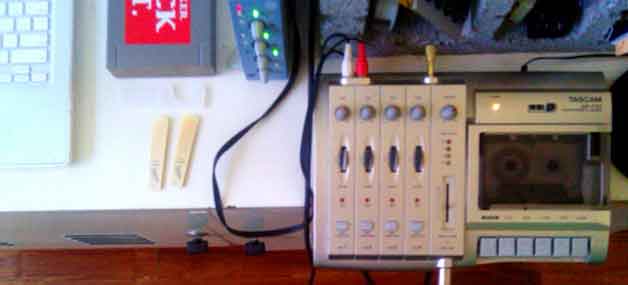Sax Mic Positioning for Home Recording

Getting a beautiful and distinctive saxophone sound in the recording studio is a bona-fide artform. What I’d like to do here is provide just a few basic guidelines that we sax players can use in our own home studios, using a single mic as we experiment to find what works best for the sound that we’re trying to get.
- The closer you place the saxophone, the more low frequencies you’ll pick up, generally resulting in a darker sound. If you want a massive amount of low frequency to be picked up, then experiment with placing the mic inside the bell of the horn. This can, however, make for a pretty abrasive sound which you’d probably have to compensate for by rolling off some low frequencies using EQ. Definitely not a very common way to position your mic, but since it’s music and there are no rules – you know the drill…
- Generally speaking, the sax mic is placed around 6 inches off the bell of the horn. Point the mic downwards at a 45-degree angle for a bigger and more aggressive sound. Otherwise, pointing the mic straight towards upper key holes at a 90 degree angle will result in a “smoother” sound.
- When positioning the microphone near the bell, it is likely that the lower notes will come out louder than the higher notes making for unevenness in volume throughout the horn. Moving the mic to one side of the horn is one solution that may help to remedy this issue.
- Moving back a bit from the mic will bring out some of the higher frequencies resulting in a brighter sound. However, unless the room you’re recording in is very well insulated and sounds more or less “dead,” then you’re likely to also pick up the a lot of the sound of the room, which may or may not be desirable. Generally speaking, I prefer to have my sax recordings as “dead” as possible so that I can exercise maximum sonic control over the track during mixdown.
- If you’re looking for a darker and less direct sound, try moving the mic below the horn.
- If you’d like to have the mic placed back a bit more for those brighter frequencies, then a general rule of thumb is to place the mic the same distance away from the front of the instrument as the length of the instrument.
- Beware the music stand! Although they look harmless enough, music stands – especially those metal ones, can cause a very noticeable reverb effect on your recording if placed directly behind your mic. Put the music stand off to the side of the mic enough so that you’re not blaring into the stand with your unintentionally-modified sound reverberating right back into your recording.
In the end, it all comes down to experimentation. Ask ten different recording engineers for the best way to mic a sax, and you’ll get ten different responses.
My hope is that by providing these basic guidelines, you’ll be able to save yourself some time and quickly address challenges that may come up during the home recording process.
Now get back to recording that instant classic!





